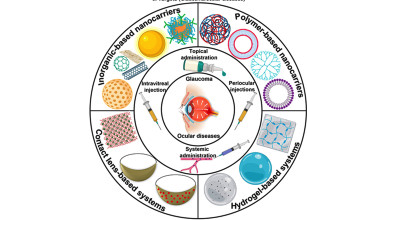


The treatment of glaucoma is currently challenging due to the innate mechanics of ocular barriers that limit the penetration of ophthalmic drugs. To tackle this, various carriers (inorganic-, polymeric-, hydrogel-, or contact lens-based) with specialized physical and chemical properties have been intensively studied.
These carriers-drug formulations have shown significant improvement in various aspects such as ocular barriers penetration, bioavailability, sustained release of drug, tissue targeting, and lowering the IOP. The delivery systems can be administered through various routes (intravitreal or periocular injection, or systemic route), enabling the drugs to reach the damaged sites and help to recover the damaged optical nerves, thus considered an effective treatment strategy for glaucoma.
In this review, we thoroughly investigate the recent advances in ocular delivery formulations focusing on glaucoma, including nanocarrier types, delivery route, and the efficacy in vitro and in vivo, clinical availability, and future outlook.
Glaucoma is a chronic ocular disorder characterized by dysfunctional of optical nerve and associated visual field loss by progressive impairment or retinal ganglion cells (RGCs) death and second most prominent reason of blindness after age-related macular degeneration globally1,2.
The World Health Organization (WHO) report entitled “world report on vision” published in 2020 claim that at least 76 million individuals are suffering from glaucoma and is predicted a significant surge of 1.3 times by 20303. Currently, the most frequently used medication method to management and treatment of glaucoma is topical administration (i.e., eye drop). However, the major challenges are limited period precorneal residence with the desired dose, inadequate corneal access, and low ocular bioavailability4.
A sum of 74% of glaucoma patients use topical treatment with eye drops to an alternative treatment method such as 3-monthly subconjunctival injections5. Injections or implants in the subconjunctival area have been reported to be non-invasive and well-accepted by many patients in the management and treatment of glaucoma. Recent years, a huge surge has been found for the development of controlled and on demand sustained ocular drug delivery systems for glaucoma treatment6,7. An excessive intra ocular pressure (IOP) often associates with glaucoma. Nanocarriers are promising, safe and effective approach to address the low bioavailability and subsequent IOP fluctuations via a controlled delivery system with sustained drug concentration over extended periods of time.